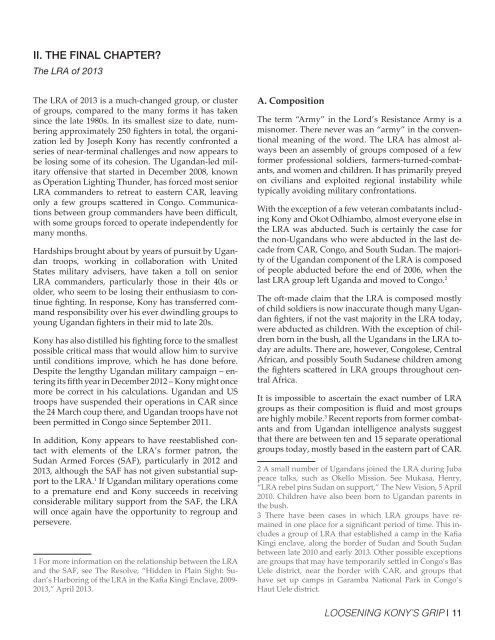Loosening-Konys-Grip-July-2013-FINAL
Loosening-Konys-Grip-July-2013-FINAL
Loosening-Konys-Grip-July-2013-FINAL
Create successful ePaper yourself
Turn your PDF publications into a flip-book with our unique Google optimized e-Paper software.
II. THE <strong>FINAL</strong> CHAPTER?The LRA of <strong>2013</strong>The LRA of <strong>2013</strong> is a much-changed group, or clusterof groups, compared to the many forms it has takensince the late 1980s. In its smallest size to date, numberingapproximately 250 fighters in total, the organizationled by Joseph Kony has recently confronted aseries of near-terminal challenges and now appears tobe losing some of its cohesion. The Ugandan-led militaryoffensive that started in December 2008, knownas Operation Lighting Thunder, has forced most seniorLRA commanders to retreat to eastern CAR, leavingonly a few groups scattered in Congo. Communicationsbetween group commanders have been difficult,with some groups forced to operate independently formany months.Hardships brought about by years of pursuit by Ugandantroops, working in collaboration with UnitedStates military advisers, have taken a toll on seniorLRA commanders, particularly those in their 40s orolder, who seem to be losing their enthusiasm to continuefighting. In response, Kony has transferred commandresponsibility over his ever dwindling groups toyoung Ugandan fighters in their mid to late 20s.Kony has also distilled his fighting force to the smallestpossible critical mass that would allow him to surviveuntil conditions improve, which he has done before.Despite the lengthy Ugandan military campaign – enteringits fifth year in December 2012 – Kony might oncemore be correct in his calculations. Ugandan and UStroops have suspended their operations in CAR sincethe 24 March coup there, and Ugandan troops have notbeen permitted in Congo since September 2011.In addition, Kony appears to have reestablished contactwith elements of the LRA’s former patron, theSudan Armed Forces (SAF), particularly in 2012 and<strong>2013</strong>, although the SAF has not given substantial supportto the LRA. 1 If Ugandan military operations cometo a premature end and Kony succeeds in receivingconsiderable military support from the SAF, the LRAwill once again have the opportunity to regroup andpersevere.1 For more information on the relationship between the LRAand the SAF, see The Resolve, “Hidden in Plain Sight: Sudan’sHarboring of the LRA in the Kafia Kingi Enclave, 2009-<strong>2013</strong>,” April <strong>2013</strong>.A. CompositionThe term “Army” in the Lord’s Resistance Army is amisnomer. There never was an “army” in the conventionalmeaning of the word. The LRA has almost alwaysbeen an assembly of groups composed of a fewformer professional soldiers, farmers-turned-combatants,and women and children. It has primarily preyedon civilians and exploited regional instability whiletypically avoiding military confrontations.With the exception of a few veteran combatants includingKony and Okot Odhiambo, almost everyone else inthe LRA was abducted. Such is certainly the case forthe non-Ugandans who were abducted in the last decadefrom CAR, Congo, and South Sudan. The majorityof the Ugandan component of the LRA is composedof people abducted before the end of 2006, when thelast LRA group left Uganda and moved to Congo. 2The oft-made claim that the LRA is composed mostlyof child soldiers is now inaccurate though many Ugandanfighters, if not the vast majority in the LRA today,were abducted as children. With the exception of childrenborn in the bush, all the Ugandans in the LRA todayare adults. There are, however, Congolese, CentralAfrican, and possibly South Sudanese children amongthe fighters scattered in LRA groups throughout centralAfrica.It is impossible to ascertain the exact number of LRAgroups as their composition is fluid and most groupsare highly mobile. 3 Recent reports from former combatantsand from Ugandan intelligence analysts suggestthat there are between ten and 15 separate operationalgroups today, mostly based in the eastern part of CAR.2 A small number of Ugandans joined the LRA during Jubapeace talks, such as Okello Mission. See Mukasa, Henry,“LRA rebel pins Sudan on support,” The New Vision, 5 April2010. Children have also been born to Ugandan parents inthe bush.3 There have been cases in which LRA groups have remainedin one place for a significant period of time. This includesa group of LRA that established a camp in the KafiaKingi enclave, along the border of Sudan and South Sudanbetween late 2010 and early <strong>2013</strong>. Other possible exceptionsare groups that may have temporarily settled in Congo’s BasUele district, near the border with CAR, and groups thathave set up camps in Garamba National Park in Congo’sHaut Uele district.LOOSENING KONY’S GRIP | 11


